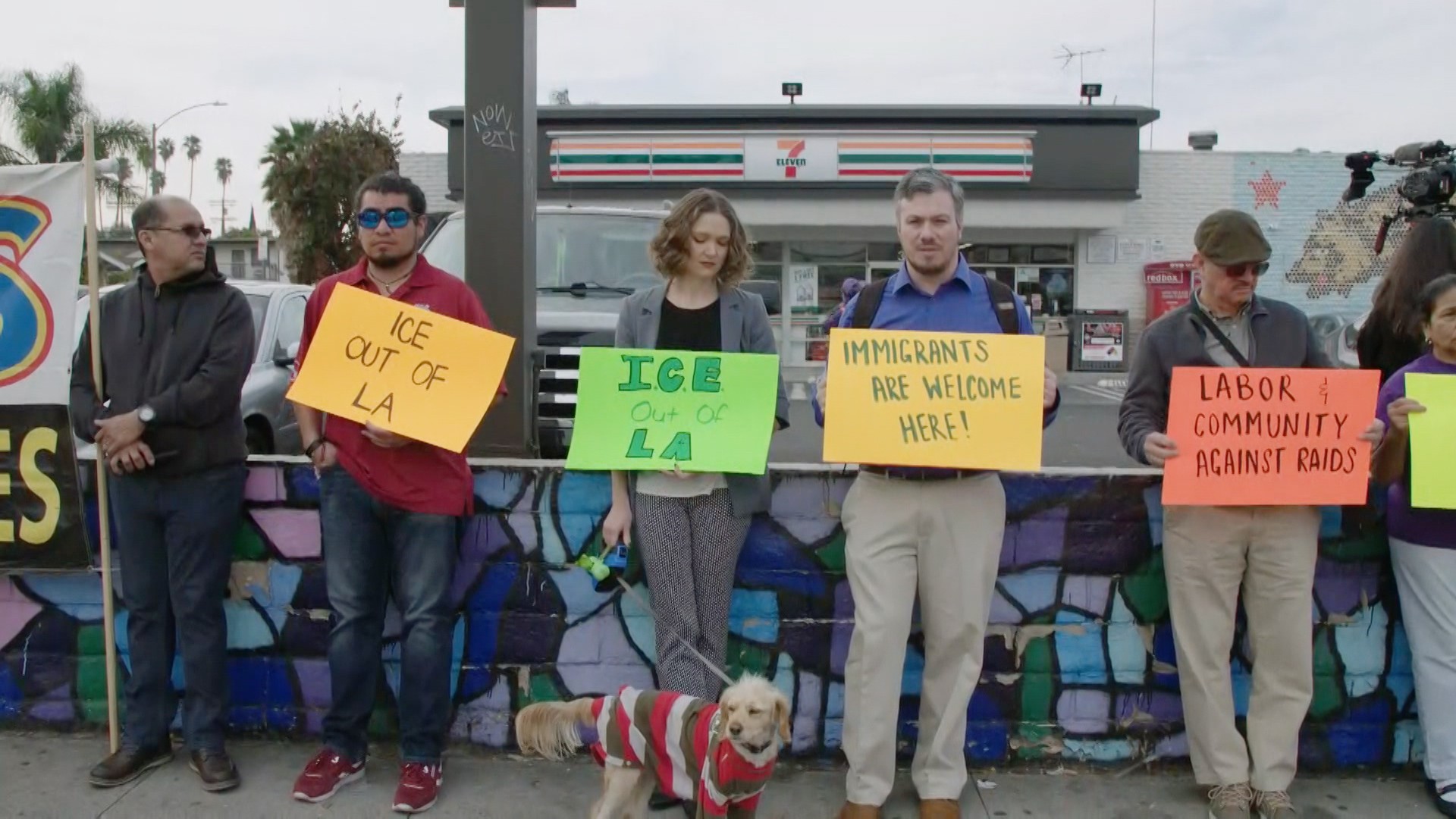Scott Bennett is filmed by a cameraman on the steps of the Martinez Financial Department.
There are two ways to get into Martinez, California. From the west, you cut through the idyllic twin hills that legendary conservationist John Muir once named after his daughters. From the east, you pass through the industrial waterside landscape of the Shell refinery that for the past century has pumped crude in from the tankers resting in the Carquinez Strait.It wasn’t clear from which direction the four men—two in trench coats, two carrying A/V equipment—came. From the moment they walked up the front steps of Martinez’s old Finance Department, it was clear they were really from a land that didn’t actually exist.“New California is a new state of development exercising its constitutional right to form,” declared Scott Bennett—who is a “counterterrorist financial analyst” according to a strange-looking wiki website—from the steps. He was speaking to anyone who happened to be watching the livestream; there were no listeners physically present. “Whenever any government becomes destructive, it is the right of the people to alter or abolish it.”This public airing of grievances is the latest move by the “New California” movement, which hopes to split California into two states. Though quixotic secession efforts are as regular as drought around here, New California got a surprising flurry of mainstream attention last week after the group released its official “Declaration of Independence.” But what he called the “overwhelming worldwide response” of website hits, emails, phone calls, and retweets didn’t translate to interest in this announcement—my photographer and I were the only media members in attendance.Luckily or unluckily, you’ll have more chances to hear the announcement—39 more grievances will be aired, every Tuesday at 11 AM, at various county buildings throughout the state.“It sounds kind of strange, but that’s the way they used to do it in the old days,” said Paul Preston, the founder of the movement, who told me they’ll keep the specific locations of future airings secret until the day before. “It’s controversial, and I well imagine that people will be trying to shut us down.”Preston says he began thinking about a secessionist movement five years ago, when he linked up with the folks behind the proposed 51st State of Jefferson, an organization trying to break California into two states, the northern one encompassing the far more conservative chunk of the state. But when Jefferson’s leadership decided on a strategy of using “the lawsuit option,” Preston became disenchanted and decided to start his own secessionist movement. (Neither of these efforts are to be confused with venture capitalist Tim Draper’s plan of splitting California into six different states, which, according to Preston, “isn’t going to succeed.”)

In May of last year, Preston, a resident of Yuba City—40 miles due north of Sacramento and a short drive from Rough and Ready, a town that seceded from America for a few months in 1849 until it ran out of booze—began reaching out to like-minded individuals throughout the state. He says he vetted them to make sure “they’re competent and capable, and in a position where they can understand the process and move forward.” The plan is for each to start their own county committee, a process that he hopes will galvanize groundswell support enough to bypass the state government in Sacramento and bring their case to the federal level.“We are a neutral body moving forward to persuade, ultimately, the Legislature and Senate to approve our state split,” said Preston, who stakes his movement’s claim to legitimacy on Article 4, Section 3 of the US Constitution, which says that new states can be formed out of existing states as long as the US Congress and the relevant state legislature give their approval. “You know those crazy guys with those pocket Constitutions? There’s a reason for it,” said Preston.To become involved in these committees, one must either be a resident of the county it is representing, or a resident of the state and a landowner of the county. This distinction is important, as it highlights the ideological split between “one person, one vote” and “one acre, one vote” that seems to be at the core of this effort. “What we have is a lack of representation in New California,” said Preston. “In rural communities, we are not represented properly.”To Preston, this is due to the 1964 Supreme Court case Reynolds v. Sims, which dictated that state legislative districts must be drawn with roughly equal population numbers in mind. This ruling has predictably led a state district map that’s composed of huge chunks in the rural areas, and microscopic puzzle pieces in the urban ones. If one believes that land ownership should dictate the power of one’s vote, this is infuriating; if one leans to the right, it’s doubtless frustrating that the population-based rule has given Democrats a near-supermajority in both chambers of the California Legislature.Despite Preston’s claim that his movement isn’t intended to divide the state along “liberal versus Republican” lines, the group’s reliance on preexisting county borderlines has resulted in extremely pliable definitions of “rural” and “urban.” According to the proposed map, “Old” California will consist of the greater Bay Area and parts of the delta watershed into Sacramento, but not Contra Costa County, the most conservative part of the Bay. It will also include most of the coastline down into Los Angeles, but not the heavily populated counties of San Diego, Orange, Riverside, San Bernardino, or Fresno, which are also relatively conservative. “At some point we have to have some population,” said Preston of those lines.It’s also hard not to see that this secessionist effort is tinged with a heavy coat of the same right-wing reactionary outrage that simmers in the rural areas. Preston is the founder of the conservative streaming station Agenda 21 Radio, a member of the “American Exceptionalism News Network,” which seems like a network of exactly one program. Its website is littered with references to MS-13, the gang with Central American roots that’s become a fear-baiting symbol among conservatives, and stories like “Historic German Church Demolished as Mosques Multiply Across the Country.” (“Agenda 21” refers to a nonbinding UN sustainable development plan that is often cited by anti-globalist conspiracy theorists.)These simmering nationalistic tendencies were on display in the airing of New California’s first grievance on the empty Financial Department steps in Martinez.“Citizens in California are no longer afforded proper United States Constitutional guarantees and protection, but instead are subjected to domestic violence and lawlessness, which is killing, wounding, and maiming legal California citizens at the hands of foreign, illegal non-citizens,” Bennett addressed the crowd that wasn’t there. “An illegal and unconstitutional quote-‘sanctuary’-unquote state status has been legislated by a mono-party and signed by a dictator, declaring unconstitutional protections to illegal non-citizens who have invaded California and created an excessive financial burden.”All in all, it was a very quiet, unremarkable morning. The four-man crew finished their airing of grievances in about 15 minutes, and then went back to where they came from.Sign up for our newsletter to get the best of VICE delivered to your inbox daily.Follow Rick Paulas on Twitter and Stephen Loewinsohn on his site.
Advertisement
Advertisement

In May of last year, Preston, a resident of Yuba City—40 miles due north of Sacramento and a short drive from Rough and Ready, a town that seceded from America for a few months in 1849 until it ran out of booze—began reaching out to like-minded individuals throughout the state. He says he vetted them to make sure “they’re competent and capable, and in a position where they can understand the process and move forward.” The plan is for each to start their own county committee, a process that he hopes will galvanize groundswell support enough to bypass the state government in Sacramento and bring their case to the federal level.“We are a neutral body moving forward to persuade, ultimately, the Legislature and Senate to approve our state split,” said Preston, who stakes his movement’s claim to legitimacy on Article 4, Section 3 of the US Constitution, which says that new states can be formed out of existing states as long as the US Congress and the relevant state legislature give their approval. “You know those crazy guys with those pocket Constitutions? There’s a reason for it,” said Preston.
Advertisement
Advertisement
